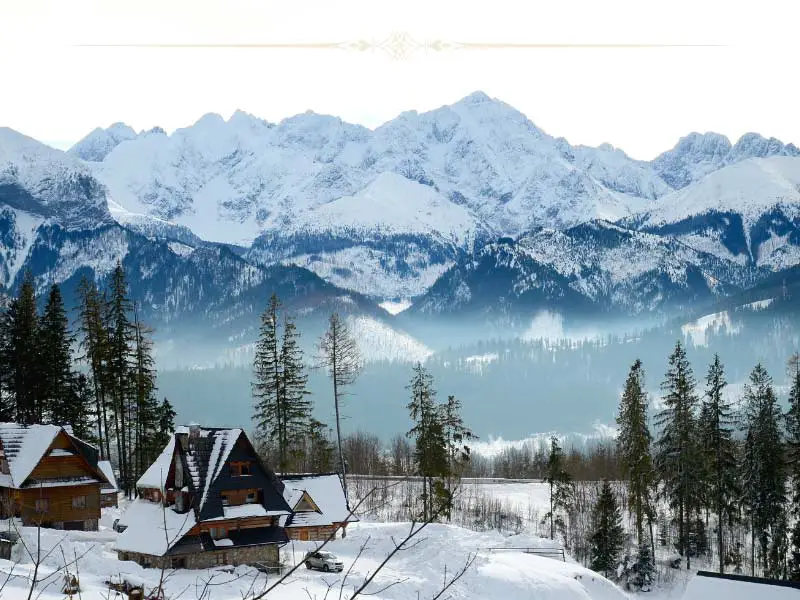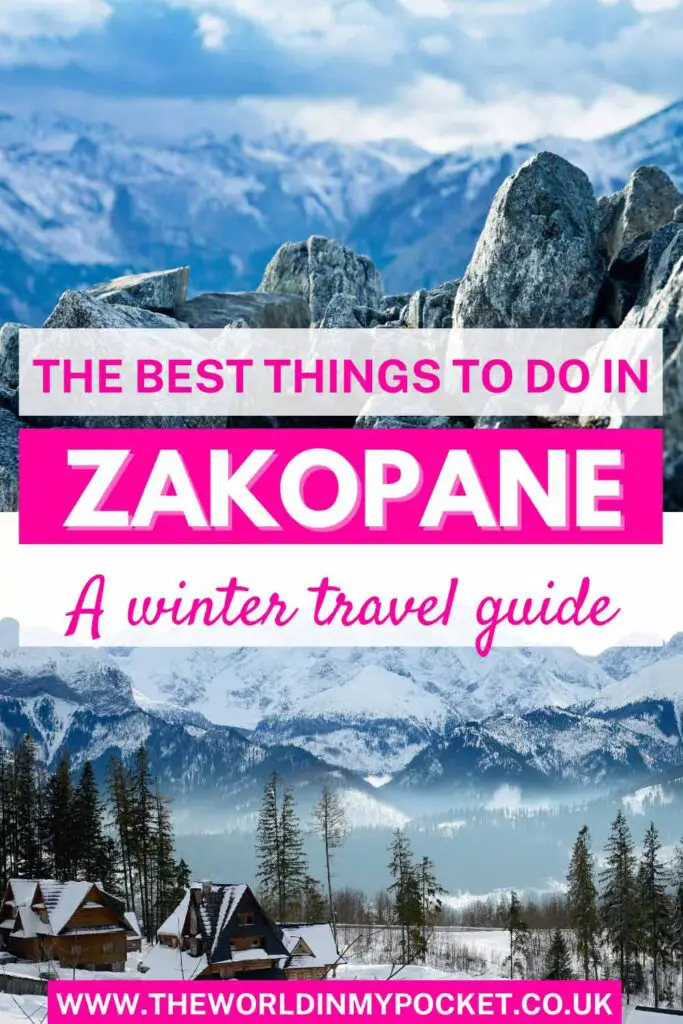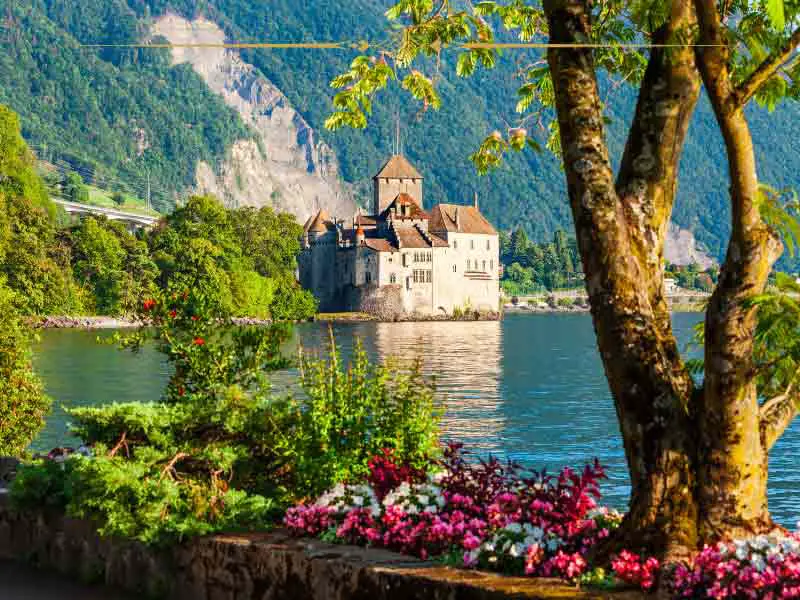The fabled Winter Capital of Poland was an alluring place after spending too long loafing around the big city of Krakow. I was done with trams and buses and traffic and bars. I was ready to breathe the fresh, cold air of the Podhale, the southernmost region of Poland where the serrated ridges of the Tatra Mountains unfold against the Slovak border.
Just two hours on the bus was enough to swap the concrete jungle for the hills. The moment I stepped out onto the ice-caked streets of Zakopane I knew I’d made the right choice. Pillows of snow were stacked against the sidewalks, smoke snaked from cottage chimneys, and there, on the horizon, the great Carpathian Mountains felt closer than ever.

It was tales of snow-capped peaks and wooded valleys, of Polish poets finding a muse in the highlands, of smoked sheep’s cheeses and crackling fires in old timber taverns that first drew me to Zakopane, Poland’s escape in the mountains.
This guide will run through everything you need to plan the perfect getaway to Zakopane in the winter. It will outline exactly what to expect from the town during the depths of the cold season, the top things to do, and the practicalities of traveling there from Krakow.
Where is Zakopane?
Zakopane is located in southern Poland, at the base of the Tatra Mountains. They line the border with Slovakia, so this is just about as far south as it’s possible to go in the country.
The town is roughly 100 kilometres south of Krakow, making it a popular destination for day trips or weekend getaways from the city.
The town lies within the Lesser Poland Voivodeship (Małopolskie), and its position at the foot of the Tatras places it as a gateway to Poland’s only alpine mountain range and best ski resorts.
It’s also just over 800 meters above sea level. That keeps it a bit colder than Krakow and neighbouring towns and cities and means there’s usually plenty of snow around when the winter comes.
How to get to Zakopane?
I’ll assumed you’ll be beginning your journey in Krakow. Most people do. Krakow’s John Paul II International Airport is the closest air hub and most buses and trains pass through here (or begin here) on their way towards the mountains.
There are two main ways to arrive in Zakopane:
- Bus – Buses run every 15 minutes or so from Krakow’s main station, taking around two hours to get you to Zakopane. They’re not expensive – tickets are between $3-5 per person, each way. Some buses stop in towns like Nowy Targ along the way, which can add some time. Buses are the best way to travel in winter because trains can be delayed by snow on the tracks.
- Train – The train from Krakow to Zakopane is quite slow. It takes three hours compared to two hours on the buses. However, it’s a comfier choice. Sadly, it costs a bit more and can suffer from delays in winter when the tracks freeze over (it happened to me!).
What’s the weather like in Zakopane in winter?

Cold. Very, very cold.
Yep, Zakopane is one of Poland’s most iconic ski towns. Not only is it high up, but it’s located deep within the heart of continental Europe. That brings weather patterns that can see regular sub-zero temperatures from November through to March.
Snow is very likely. I’ve visited twice in the winter now and both times there was a layer of thick white stuff on the ground, with more snowfall coming at night. On average, Zakopane sees nearly a meter of snow fall throughout the season, though the mountains around the town can see as much as double that – good news, since many of them are used for skiing!
If you do decide to visit Zakopane in the winter, then be sure to bring thermal wear – that means underlayers, midlayers and outers, plus gloves and good boots. If you do forget anything, then the whole main road here is a string of top-notch outdoors shops that sell just about everything you could need.
Things to do in Zakopane in winter
Zakopane has two peak seasons: The middle of the summer and the whole of the winter.
The first is popular mainly with hikers. The walking in the national park – the Tatra National Park – that buts up to the south side of the town is second to none in Poland. The trails tend to open in March but are at their best with the warm weather months of June, July, and August.
The winter is the ski season, which is why hitting the slopes has to figure highly here. But, don’t worry, there’s also plenty more on offer in Zakopane if you’re not into the downhill…
Go skiing in Zakopane

Zakopane is the most famous ski town in Poland. There are 15 individual ski fields in the valley here and in surrounding valleys, so there are plenty of slopes to get stuck into.
One thing to know is that the skiing here isn’t really like the skiing in the Alps. There’s no single interlinked resort. Instead, it’s more single-run slopes that you pay for individually.
On top of that, most of the ski runs are below the treeline and generally quite shallow and wide. They’re also among the cheapest I’ve visited – I paid just 150 PLN ($39) for a full day’s pass on one of the town’s longer ski runs.
My choice was Polana Szymoszkowa. I liked it because it was within walking distance of the centre of Zakopane and easily linked to the main street by a short ski bus (costing $1). It’s essentially a two-slope resort with a top station that has some moguls and a lovely café with views of the Tatra Mountains, which sit across the valley.
I’d say it’s just about perfect for beginners and learners who want to practice because there’s a nice wide section that’s reached by a separate chairlift below the main slope.
Other ski runs you can visit here include:
- Kasprowy Wierch – The highest ski resort in Poland, this one’s inside the Tatras themselves. It’s reached by a classic gondola about 15 minutes’ drive south of Zakopane town and goes up to nearly 2,000 meters.
- Bialka – The largest ski area in Poland is about 20-30 minutes’ bus from Zakopane in the next valley over. It’s worth the trip if you’re with a family because the runs here are super welcoming and there are great ski schools.
Do a winter valley walk

The moment I was off the ski runs, I couldn’t resist the pull of the Tatra National Park any longer.
Someone I spoke to told me that many of the hiking paths aren’t safe in the winter, so I did some digging and asked at my hotel reception for some tips.
It was true that the most iconic high routes – to the peak of Rysy (Poland’s highest mountain) and Giewont (the amazing mountain you can see from Zakopane) – weren’t fully safe for winter walking and needed specialist equipment.
However, there were some lovely valley walks in the foothills of the national park that I decided to go for.
I picked the route up a valley called Dolina Strążyska because it was one of the few accessible from the town centre by foot. The entrance to the park has a small kiosk where you’re asked to pay an entry fee of about $2 and then you’re free to go in.
Wow. The hike was on a meandering cobblestone path past a ice-caked river and fir trees plumed in snow. After a while, it crosses fairy-tale wood bridges and goes into a glade covered in virgin snow. There’s a small hut there that sells hot chocolate and Polish soup to help you warm up and a frozen waterfall just behind.
Be wary of the avalanche risk. There’s a warning sign at the entry point to the national park that should tell you if it’s too dangerous; even the valley walks can be tricky if the avalanche risk is high.
Do the walk to Morskie Oko

On my second morning in Zakopane, I decided to make the jaunt over to Morskie Oko. Several people had recommended this one to me and I just had to see it: A high-up lake perched under the jagged top of Poland’s tallest mountain.
I had to take an early bus from the station for about 30 minutes, going to a place called Lysa Polana. There, a wide, tarmacked trail runs directly south, skirting the Slovak border through pine forests.
After about an hour’s walking I came to a big clearing where there were toilets and some seating for a hard-earned rest. Then the trail bolted off to the left and up higher, though it was still wide and easily accessible.
Another 1.5 hours’ hike through the forests and viola: I emerged onto the edge of a half-frozen alpine lake, shrouded by an amphitheatre of dagger-like summits. Snow and clouds hugged the top of the ridges as I opened my thermos and sipped a warming hot chocolate.
It really is a sight to behold up there!
Cozy taverns and restaurants on Krupowki Street
There’s a certain atmosphere to Zakopane. The town is the home of the Podhale culture; a tradition that runs back centuries and is all about mountain life.
The most distinct thing you’ll notice is the architecture. It’s like something out of a Christmas book. Homes of carved timber and steep roofs abound, all with chimneys that poke out high above the rooftops.
Do not miss the main street of Krupowki. It’s a medley of this handsome mountain architecture and where you’ll find many of the most cozy places to dine and drink in Zakopane.
I settled on the lovely Karczma Zapiecek midway up the street. A roaring log fire and a menu of Polish pierogi dumplings and potato pancake were what sealed the deal. It was lovely and filling, with a toast of traditional mountain vodka to dust things off.
On my second day I also managed to get a taste of the local delicacy: Oscypek. This smoked sheep’s cheese is sold at BBQs up and down the main street with a side of cranberry sauce. It’s salty and chewy and downright tasty to boot!
Hot springs
Zakopane is at the centre of a region that’s well known for its mineral baths.
Sadly, I didn’t have time to visit them (at least not this time around) but I’m told the experience of bathing in 40-degree water surrounded by snowfall is something pretty special.
There are a few spa complexes in the region around Zakopane that you can visit on a daytrip or using public transport.
The most famous is probably the bathhouse below the ski slopes at Bialka Tatrzanska. A bus there from Zakopane takes about 30 minutes and you’ll find the Thermal Baths (known as Termy Bania) right at the base of the lifts by where you purchase ski passes.
Even closer to Zakopane itself is the newer bath system of Termy Chocholowskie. These come with indoor and outdoor pool areas, a whole sauna section, and all manner of other wellness things. What’s more, they’re located in a UNESCO World Heritage village to the west of Zakopane, where you can see old-style log cabins build from complete tree trunks.
Zakopane in Winter – My Conclusion

A trip to Zakopane in the winter is perfect if you’re keen to slow things down and get a sample of a proper winter wonderland. This town has an idyllic location below the Tatra Mountains, offers skiing for cheap and cozy taverns aplenty. It’s also a spa centre, which means you can soothe post-ski muscles with a bath in a hot spring if you have the time.
Like it? Pin it!

Disclaimer: Some of the links on this website are “affiliate links.” This means that if you click on the link and do a purchase, I will receive an affiliate commission at no extra cost for you. This helps me keep my website running and continue to share my travelling knowledge with you. I thank you for booking your flights or hotels using the links on my website. Regardless, I only recommend products or services I use personally and believe will add value to my readers.

